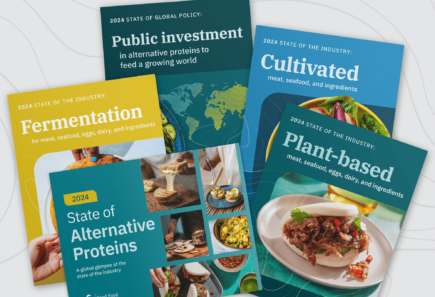
U.S. foodservice market insights for plant-based foods
Explore our overview of foodservice market data for plant-based proteins and dairy in the U.S., 2020-2024, including category sales, product types, formats, ingredients, and consumer perceptions.
Dive into the full report
Foodservice is a key channel for plant-based foods
Foodservice is a crucial channel for plant-based brands and companies to reach consumers, and offering plant-based dishes enables foodservice operators to tap into the large market interested in plant-based eating.
By delivering accessible and often elevated experiences, foodservice can drive awareness and engagement with the plant-based category.
- Put the best foot forward. Professionally prepared dishes bring ingredients to life in delicious ways and remove hurdles for consumers preparing meals themselves.
- Reach consumers on more occasions. Distribution across retail and foodservice increases accessibility, enabling consumers to choose plant-based options more frequently.
- Collect feedback easily. Foodservice can be a strategic outlet for launching products and securing feedback from foodservice consumers and operators.
Key takeaways
While plant-based protein sales declined, some formats and operator segments saw growth
The plant-based proteins category—which includes analog meat and seafood, tofu, tempeh, and grain/nut/veggie items—dollar sales were down five percent and pound sales down four percent in 2024. Dollar sales were still higher than in 2020, reflecting a four percent CAGR from 2020 to 2024.
Analogs accounted for more than half of plant-based protein pound sales, reflecting consumer preference for products that mimic the taste and functionality of animal meat. Notable bright spots included the plant-based pork category and specific formats, such as plant-based pork patties, chicken tenders, and chorizo sausage, which all experienced growth. Tofu and tempeh also saw sales gains.
While restaurants remain the largest purchasers of plant-based proteins, sales to healthcare, business, industry, and government operators expanded in 2024.
Price and taste continue to be key barriers to consumers choosing plant-based options
Consumer research consistently finds that improvements to taste and texture, as well as price, are critical to driving plant-based adoption, both overall and in the foodservice sector. In addition to product innovation to improve taste, leveraging familiar flavors and formats in plant-based dishes, supporting trial (e.g., via samples), and engaging with chefs to ensure an elevated taste experience are key levers to overcome consumer taste concerns in foodservice environments and drive trial and repeat of plant-based dishes.
Plant-based milk and creamer experienced continued growth
Plant-based milk dollar sales were up nine percent and pound sales up six percent in foodservice in 2024, according to Circana. Conventional milk sales also grew, so plant-based milk continued to hold a 12 percent-pound share of the total milk category in broadline distributor sales.
Plant-based creamer also experienced growth, reaching an impressive 31 percent of total creamer pound sales. Plant-based milk and creamer are expected to enjoy additional headwinds in 2025 as top coffee chains remove plant-based dairy surcharges.
Plant-based eggs have grown significantly in recent years
While plant-based eggs represent a small category in foodservice with a one percent share of the total egg market, the category grew by 28 percent in dollar sales and 30 percent in pound sales in 2024 alone. Plant-based eggs may be poised to capture additional share as egg prices rise and supply chains become volatile due to the avian flu. Learn more about plant-based and fermentation-enabled innovations in egg substitutes in our industry update on the emerging egg alternatives category.
Plant-based cheese saw losses
Plant-based cheese declined in 2024, losing 12 percent in pound and dollar sales. Closing gaps on taste and texture will be critical for plant-based cheese to gain share in the massive foodservice cheese market, which is seven times the size of the foodservice milk market.
Consumer affinity for eating out continues to grow
The total foodservice sector has seen steady growth since the downturn caused by the COVID-19 pandemic. In 2024, the share of consumer spending on food away from home reached a new high, surpassing pre-pandemic levels and increasing the gap in spending on food at home. Circana data on total food operator purchases from broadline distributors showed a four percent growth in dollar sales and a two percent growth in pound sales in 2024.
The sector still faces challenges, particularly around inflation
Recent years have presented the foodservice sector with a host of challenges, including supply chain disruptions and inflation. According to Circana, the average food price per pound from distributors to operators increased 30 percent between 2020 and 2024. While 2024 saw wholesale food prices and inflation ease, consumers continue to express concern and frustration about food costs that are impacting their food-buying behaviors.
Untapped potential
There is a large addressable market for plant-based foods
In a 2024 study conducted by GFI, almost three-quarters (71 percent) of U.S. consumers aged 18-59, representing diverse attitudes and motivations, reported that they are at least somewhat likely to eat plant-based meat and/or dairy in the future. Half of those consumers said they would be likely to consume plant-based meat in restaurants or cafeterias. This was even higher among certain consumer segments.
The availability of plant-based meat dishes in foodservice would motivate consumers to eat more plant-based food
More than one in 10 consumers say that a top five factor that would make them consider plant-based meat more is if products were easier to find in the restaurants they visit. Among those who have eaten plant-based meat in the past year, this rises to two in 10 who say they would consider plant-based meat more often if it were easier to find in restaurants.

Resource
Alternative Protein Opportunity Newsletter
This monthly newsletter covers the latest plant-based industry news, market and consumer research, policy updates, helpful resources, and upcoming events.
Related resources
Plant-based retail market overview
Explore sales data for plant-based meat, egg, and dairy products in the U.S. retail market. Find key category insights, size, sales growth, and purchase dynamics for the plant-based industry.

Analyzing plant-based meat & seafood sales
Dive deep into sales and consumer data for plant-based meat and seafood. Find key category insights, size, sales growth drivers, purchase dynamics, and consumer insights.

Consumer insights
Understand alternative protein consumer segments, demographics, adoption, motivations, and perceptions.

State of Alternative Protein series
Explore our comprehensive State of Alternative Proteins series for insights into the rapidly evolving alternative protein landscape.
